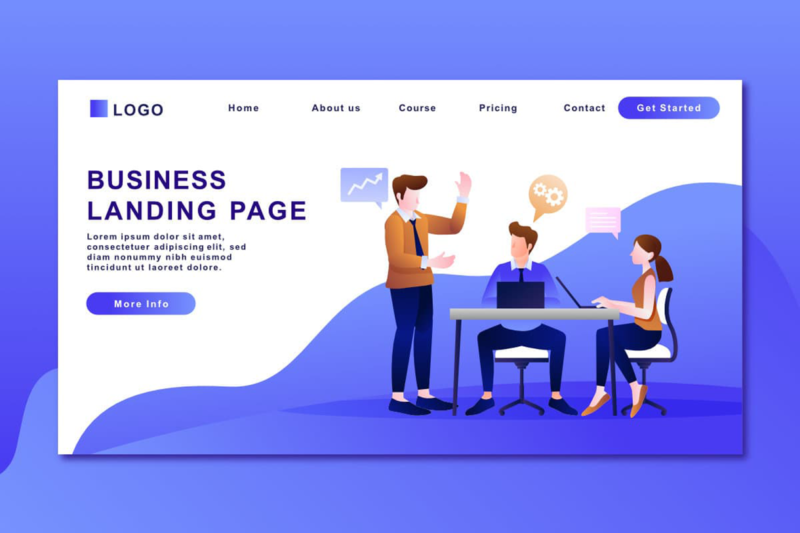
A landing page is one of the most critical elements of any online marketing campaign. It’s where you send your audience to take action—whether that’s making a purchase, signing up for a newsletter, or downloading an eBook. But not all landing pages are created equal. A killer landing page is designed to convert visitors into customers, leads, or subscribers. In this article, we’ll break down the essential components of a high-converting landing page and share tips on how to craft one that delivers results.
1. Understand the Purpose of Your Landing Page
Before you even begin designing your landing page, you need to be clear about its purpose. A landing page should have one primary goal, known as a conversion goal, such as collecting email addresses, promoting a product, or generating leads. Defining your objective helps shape every aspect of the page, from the copy to the layout.
- Single Focus: Unlike a homepage, which might have several links and multiple goals, a landing page should focus on one specific action you want the visitor to take. This clarity helps drive conversions.
- Target Audience: Know exactly who you’re targeting. This includes demographics, pain points, and needs. Tailoring your page to a specific audience increases the likelihood of conversion.
- Offer Value: The conversion goal should be backed by a valuable offer—whether it’s a discount, free resource, or exclusive content. Make sure your offer is compelling and relevant to your audience.
By clearly defining the purpose and value of your landing page, you set the foundation for an effective and focused design.
2. Write a Compelling Headline
The headline is the first thing visitors see when they land on your page, so it needs to grab attention and entice them to stay. A great headline should clearly convey the value of your offer and encourage visitors to read further.
- Be Clear and Direct: Your headline should immediately communicate what the visitor will get. Avoid vague or clever language that might confuse your audience.
- Highlight the Benefit: Focus on the main benefit or solution your offer provides. For example, instead of “Get Our eBook,” try “Learn How to Boost Your Sales by 50% with Our Free eBook.”
- Use Action-Oriented Language: Encourage visitors to take action with verbs that convey a sense of urgency or benefit, such as “Discover,” “Learn,” “Get,” or “Unlock.”
A strong, compelling headline sets the stage for a high-converting landing page by making the visitor feel like they’ve come to the right place.
3. Craft Persuasive, Benefit-Driven Copy
The copy on your landing page plays a crucial role in persuading visitors to convert. Your goal is to address the visitor’s pain points, show them how your offer provides a solution, and guide them toward taking action.
- Focus on Benefits, Not Features: Rather than listing features of your product or service, emphasize the benefits. Explain how it will improve their life, solve a problem, or help them achieve their goals.
- Keep It Concise: Your copy should be clear, concise, and easy to scan. Avoid long paragraphs and stick to bullet points or short sections to maintain readability.
- Use Social Proof: Testimonials, reviews, or case studies can help build trust and credibility. Highlight the success stories of others who have benefited from your offer.
Effective landing page copy speaks directly to the visitor’s needs and motivates them to act by highlighting the unique value of your offer.
4. Create a Clear and Strong Call to Action (CTA)
The call to action (CTA) is the single most important element of your landing page because it’s what drives conversions. A clear, bold, and compelling CTA tells the visitor exactly what action to take next.
- Use Action-Oriented Language: Like your headline, your CTA should use strong verbs that prompt action. Phrases like “Download Now,” “Sign Up Today,” or “Get Started” are direct and effective.
- Make It Stand Out: The CTA button should be visually distinct from the rest of the page. Use contrasting colors, large fonts, and a prominent placement to ensure it catches the visitor’s eye.
- Create Urgency: Adding a sense of urgency can increase conversions. Phrases like “Limited Time Offer” or “Only X Spots Left” create a fear of missing out and encourage immediate action.
A well-crafted CTA not only tells visitors what to do but also motivates them to take action right away.
5. Optimize Your Form for Conversions
If your landing page involves collecting information (like email addresses or sign-ups), the form is a critical element. A poorly designed form can be a major barrier to conversions, so it’s important to keep it simple and user-friendly.
- Ask for Essential Information Only: The fewer fields you ask visitors to fill out, the higher your conversion rate will be. Only request the information you absolutely need, such as name and email address.
- Use Clear Labels: Make sure each field in the form is clearly labeled so visitors know exactly what information is required.
- Add a Privacy Statement: Reassure visitors that their information is safe and won’t be shared or misused. A simple “We respect your privacy” statement can help alleviate concerns.
A streamlined, easy-to-use form reduces friction and encourages more visitors to complete the conversion process.
6. Use Visuals to Support Your Message
Images, videos, and graphics can enhance the effectiveness of your landing page by supporting your message and helping visitors understand your offer more clearly. However, visuals should be used strategically and not overwhelm the page.
- Use High-Quality Images: Choose images that are relevant to your offer and visually appealing. Avoid using stock photos that feel generic or impersonal.
- Include Explainer Videos: If appropriate, an explainer video can help clarify complex products or services. Videos are highly engaging and can increase conversion rates.
- Keep It Simple: Visuals should enhance the message, not distract from it. Avoid cluttering the page with too many images or unnecessary design elements.
The right visuals can make your landing page more engaging and help visitors better understand the value of your offer.
7. Leverage Social Proof and Trust Signals
Trust is a key factor in landing page conversions. If visitors don’t trust your brand, they’re unlikely to take the desired action. Building trust through social proof and trust signals can reassure visitors that they’re making the right decision.
- Customer Testimonials: Including positive feedback from satisfied customers can build credibility and show that others have benefited from your offer.
- Trust Badges: Security badges, payment seals, or third-party endorsements can reduce friction and make visitors feel more comfortable sharing their information or making a purchase.
- Case Studies and Success Stories: Show real-life examples of how your product or service has delivered results for customers. This adds tangible proof of value.
Social proof provides the reassurance visitors need to move forward with confidence.
8. Ensure Mobile Optimization
With more than half of all web traffic coming from mobile devices, optimizing your landing page for mobile is essential. A poorly optimized mobile page can result in a high bounce rate and lost conversions.
- Responsive Design: Ensure your landing page is fully responsive and adapts to different screen sizes. A mobile-optimized page should load quickly and function seamlessly on smartphones and tablets.
- Mobile-Friendly Forms: Simplify your forms for mobile users. Use larger buttons, easy-to-read fonts, and auto-fill options to make the form-filling process smoother.
- Minimize Load Times: Speed is crucial on mobile. Compress images, reduce page size, and avoid unnecessary scripts that slow down loading times.
By optimizing your landing page for mobile devices, you create a smooth experience for visitors on all platforms, increasing the likelihood of conversion.
9. A/B Testing: Optimize for Better Performance
No matter how well-designed your landing page is, there’s always room for improvement. A/B testing allows you to test different versions of your page to see which performs better. This data-driven approach helps you optimize your landing page for maximum conversions.
- Test One Element at a Time: When conducting A/B tests, focus on one element at a time, such as the headline, CTA, or form layout. This allows you to pinpoint what changes are driving improvements.
- Track Key Metrics: Pay attention to conversion rates, bounce rates, and time on page to measure the impact of your changes. This data will guide your optimization efforts.
- Test Regularly: Optimization is an ongoing process. Regularly test different variations of your landing page to continuously improve performance.
A/B testing is a powerful way to refine your landing page and ensure it’s converting at its highest potential.
Conclusion: Crafting a Landing Page That Converts
A killer landing page is one that’s designed with a clear purpose, compelling copy, and a strong call to action. By focusing on the visitor’s needs, optimizing for conversions, and continuously testing and refining your design, you can create a landing page that not only attracts visitors but also converts them into loyal customers or leads. Remember, the key to success is providing value, building trust, and making the conversion process as seamless as possible.




